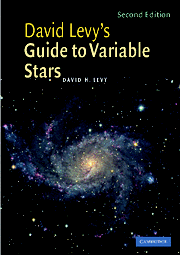Book contents
- Frontmatter
- Contents
- Foreword to the first edition
- Preface
- Acknowledgments
- Part I Getting to know the sky
- 1 Beginning with the Big Dipper
- 2 Magnitude, color, and distance
- 3 A word on binoculars and telescopes
- 4 Learning to see
- Part II Getting to know the variables
- Part III Suggested variables for observation throughout the year
- Part IV A miscellany
- Index
1 - Beginning with the Big Dipper
from Part I - Getting to know the sky
Published online by Cambridge University Press: 05 August 2012
- Frontmatter
- Contents
- Foreword to the first edition
- Preface
- Acknowledgments
- Part I Getting to know the sky
- 1 Beginning with the Big Dipper
- 2 Magnitude, color, and distance
- 3 A word on binoculars and telescopes
- 4 Learning to see
- Part II Getting to know the variables
- Part III Suggested variables for observation throughout the year
- Part IV A miscellany
- Index
Summary
The best way to get a good start on observing is to discover the stars for yourself. Becoming familiar with the sky – on your own terms – is an important first step toward useful observation.
We do need a place and time to start, so let's try your backyard, under an evening sky of late spring or early summer. High in the west will shine the seven bright stars of the Big Dipper, possibly the best known asterism, or group of stars, in the entire sky. Since Roman times they have been part of Ursa Major (UMa), the Great Bear. The Dipper's handle represents the tail of the Bear, while the feet and nose are shown by fainter stars to the south and west of the bowl (Fig. 1.1).
The Dipper as a road sign
Much as I have tried, I have never seen a bear in the region of Ursa Major, or a plough. The seven stars of the Big Dipper, however, are easy to spot. At any time of night and in any season of the year, the two stars at the end of the Dipper's bowl point towards Polaris, the North Star. All the stars in our sky, the Sun included, circle the celestial poles, and for our lifetimes Polaris will stay within a degree of the true North Celestial Pole. Polaris is the brightest star of another constellation, Ursa Minor or the Little Bear.
- Type
- Chapter
- Information
- David Levy's Guide to Variable Stars , pp. 3 - 9Publisher: Cambridge University PressPrint publication year: 2005

